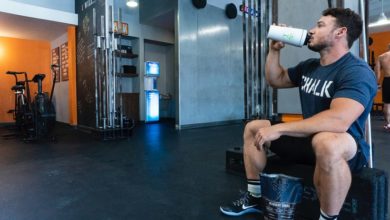
Bodybuilding is all about supercharging mass through progressive overload, volume and effort. But how important is tempo training for building good quality slabs of muscle?
The key to developing huge slabs of hard, lean muscle, solid strength and blistering speed is program design.
Chances are you know all about reps and sets. You’re familiar with how to choose the best exercises, and you’re more than likely clued up on all things to do with volume load.
But how familiar are you with time under tension?
Because that’s what tempo training is all about.
In this article we break down the latest research on tempo training. Is slow and controlled better than ballistic and powerful for muscle growth?
Let’s find out…
What will you learn?
- Tempo training involves purposely slowing down your rep speed. It’s based around principles of ‘time under tension’ and is designed to maximize muscle growth.
- Volume load is the primary driver of muscle growth, and mechanical tension is the main mechanism by which it occurs.
- Although popular with lifters, there’s no science to suggest that tempo training boosts muscle mass in bodybuilders compared to traditional lifting.
- You can still utilize tempo training for improving technique, rehab or improving mind-to-muscle connection.
Strength Training Basics
There’s nothing that even comes close to the feeling you get from getting stronger, leaner or more muscular. As a bro you’ll know exactly what we mean.
Whether it’s the glances from strangers, questions from envious noobs or the endless amount of ass you get from girls.
In our world, bodybuilding is both a sport and a passion.
When it comes to the science of strength training, the best results come from evidence-based practice – combining research with experience.
And that’s where we come in. Not only do we love to get deep in the science, we also like to get heavy in the weights room.
If you want to improve strength and grow good quality muscle, fast, here’s what you need to know:
- Specificity – Your body only adapts to the specific to the stimulus placed upon it. In other words – if you want huge, vascular arms you’ve got to train them in the right way. You won’t get them from going out jogging.
- Progressive overload – To force the body to grow new muscle cells and keep improving, you have to provide a stimulus it’s unaccustomed too. Workouts should always be challenging if you want to get better. Be complacent and you’ll remain the same.
- Volume load – The primary influence of muscle growth is variable volume load. The more reps you complete at a given load, the better stimulus for developing solid mass you’ll achieve.
Where does ‘tempo’ come in?
Muscles grow through either mechanical tension or metabolic stress.
Loading a muscle up during strength training creates an environment where muscle cells respond to the stress placed up them.
While metabolic stress results in growth due to accumulation of by-products, hormonal changes and cell swelling, mechanical tension charges up muscle mass by applying tension directly to the muscle.
It makes sense at face value to think that if more mechanical loading of a muscle results in more muscle growth, longer reps will create more loading.
Putting the muscle under strain for a longer period of time to try and optimize the stimulus for growth should in theory provide better gains.
But does it?…

The Concept of Time Under Tension
Time under tension (TUT) is an approach to training where you focus on slowing down each rep to maximize how long the muscle is mechanically loaded for.
This is the basic idea – more time under tension means more growth. If you were to perform a set of 10 reps on bench press where each rep was 1 second up and 1 second down you’d have a TUT value of 20 seconds.
But if you did a set that was 10 reps of 2 seconds up and 2 seconds down you’d have a TUT of 40 seconds.
Those that advocate time under tension training suggest there’d be more growth with the longer set.
‘Time under load’ is a better explanation
Experts such as Brad Schoenfeld suggest time under tension is a misleading term, as mechanical tension is more about the magnitude of loading rather than duration.
For example, a rep at 85% 1RM would have higher levels of mechanical tension than a set at 60%1RM, no matter how many reps were completed.
It’ll take longer to fatigue with a lighter weight, therefore the time under loading conditions is increased.
What Is Tempo Training?
Tempo refers to the speed at which you lift a weight. It’s based around principles of time under tension and is designed to maximize muscle growth.
Traditionally, tempo in strength training is measured using a sequence of four numbers. As an example, if your tempo training was to be performed at 3-1-2-0:
- 3 = Is the time it takes to lower the weight. This is called the eccentric component
- 1 = The amount of time you pause at the bottom of the movement for
- 2 = This is the concentric component, or time for the lifting phase
- 0 = The time you pause at the top of the movement
There’s no exact timings for tempo training, and values change in different workouts.
It’s said that total time under tension should be 30-60 seconds in each set to optimize results though.
There are even coaches who suggest that just 1 rep lasting 45- 60 seconds in length is just as good as a traditional set of heavy presses or pulls!

Time Under Tension – What Does the Research Say?
As it stands, most evidence shows tempo training doesn’t offer any additional benefits to muscle growth in bodybuilders.
And in some cases, may even have a negative impact.
Here’s a breakdown of the most relevant studies:
Study #1. No difference between tempo training and traditional strength protocol for muscle growth
In this study, over 30 bodybuilders were randomly divided into one of 4 groups:
- Slow speed lifting: used a tempo of 4-0-10-0 (60-90 seconds per set)
- Traditional strength training: 6-10 reps per set
- Traditional muscular endurance training: 20-30 reps per set
- Control (non-lifting): Probably chilled out and played Xbox or something
All four groups completed a leg day consisting of 3 exercises (leg press, squats and leg extension). They did this for 2 sessions per week for the first week, and then 3 times per week for 5 weeks. The endurance group and tempo training group used the same relative load at around 40-60%, whereas the strength group lifted heavier with 80-85%.
Before and after the program, each bodybuilder had their muscle size measured, as well as markers of muscle growth (muscle fiber cell count, satellite cells etc.)
The results showed strength training was better than tempo training for muscle growth – but not by much.
Authors of the study suggested that tempo training could be just as effective as traditional training, but more research was needed.
[infobox]The Result: Tempo training isn’t any better or worse than traditional strength training.
[/infobox]Study #2. Tempo training results in lower levels of growth
A recent research paper by James Krieger and colleagues looked at the effects of tempo training on muscle growth. It was published in the prestigious journal, Sport Medicine as a meta-analysis – a research project using all relevant individual studies on the subject.
The review was made up of 8 studies that collectively included over 200 participants.
The results showed there was absolutely no difference in muscle mass between reps lasting between 2 and 6 seconds long (that’s a full rep including concentric and eccentric components).
[infobox]The Result: There’s no difference in muscle growth with reps lasting less than 6 seconds long.
[/infobox]Study #3. Tempo training over 10 seconds long reduces muscle growth results
If you wanted a reason not to include tempo training in your program, this would be it.
A group of 34 lifters were recruited to investigate which of the following training methods results in most growth.
- ‘Normal’ speed resistance-training – 1-2 seconds each for both concentric and eccentric components
- Slow-speed training – 10 second concentric and 4 second eccentric
Each group followed their set protocol for 6 weeks.
The results showed that while the normal strength training group increased muscle size by almost 40%, the tempo training group only increased their cross-sectional area by a poor 10%.
[infobox]The Result: Tempo training that includes concentric phases longer than 10 seconds results in decreased muscle growth.
[/infobox]So, Time Under Tension Training Is a Waste of Time?
No.
It’s not of any real use for gaining muscle, but there might be times when you want to use it.
Tempo training isn’t any better for all-out muscle mass, but there are still some benefits to applying tempo training to your lifting program.
- Develop mind-to-muscle connection
- Improve technique
- Enhance stability or rehab
Mind-to-muscle Connection Ramps Up Muscle Growth
One way to use tempo training in the short term is to enhance your mind-to-muscle connection.
This might seem contradictory at first, but hear us out first.
Research shows that by increasing mind-to-muscle connection (not just ‘moving’ the weight but focusing on using the right muscles doing the work) leads to greater muscle growth.
The difference here is that you’re not slowing down the rep just for the sake of it. You’re slowing it down just enough to ‘feel’ the muscle better.
Research shows you don’t need to lift slowly either.
But by aiming for a rep speed of 0-2-0-2, you can optimize higher loads but also enhance mind-to-muscle connection at the same time.
Slow down to improve technique
As a full-on bro you understand the importance of great technique. Not only does good lifting reduce injury potential… it helps to push mechanical tension on the right muscles too.
When you’re new to an exercise or still getting to grips with the form, it’s wise to slow things down at first.
By reducing the bar speed, you can not only increase mind-to-muscle connection, but allow your brain time to register the path of the bar, and effective technique.
How Fast Should You Lift for Muscle Growth?
We know progressive overload, load volume and even rest times can in some way affect muscle growth.
But is tempo important at all?
One thing is for sure. When you’re trying to lift heavy, you don’t give a sh*t what speed you lift at. You’re trying to move the damn weight from A to B.
Ironically, when you’re lifting heavy, the speed of the bar will be slow. But only because moving a high load is hard work. It’s not that you’re purposely trying to lift slow.
(If you do, you’ll soon find out the hard way… it doesn’t work that well at all).
The only way you can apply tempo training is with lighter loads. Because heavier ones don’t allow you to f*uck around with bar speed.
So how fast should you lift?
Don’t overthink it – you’re probably lifting at the right speed already.
Current research suggests that an optimal training tempo should be 1-2 seconds for the lifting phase (concentric), and the lowering phase (eccentric) should come in at 1-3 seconds.
Summary – Tempo Training and Muscle Growth
As bodybuilders, any advantage for muscle growth is going to be seized with two strong, chalk-covered hands.
The primary driver of muscle growth is volume, and the main mechanism by which it occurs is mechanical tension. If you focus all your attention on bar speed and tempo training you’ll reduce both. By using a lighter weight to grind out slower reps, you’re only decreasing potential for gains.
There’s currently no evidence showing slower speed training protocols such as time under tension and tempo training offer any additional benefit for muscle growth.
Focus on lifting at a natural speed with fatiguing weights for optimal progression.
What next?
Check out our training guides for more ideas on how to maximize muscle mass:






